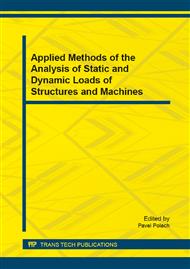p.71
p.77
p.81
p.85
p.91
p.95
p.99
p.103
p.107
Experimental and Numerical Study of Uniaxial and Multiaxial Stress-Strain Behaviour of R7T Wheel Steel
Abstract:
This paper is focused on the correct description of stress-strain behavior of the R7T steel. An experimental study on the wheel steel specimens including uniaxial as well as multiaxial tests has been conducted. The main attention was paid to such effects as ratcheting and nonproportional hardening of the material. A cyclically stable behavior of the steel under higher amplitude loading was found. The MAKOC model, which is based on AbdelKarim-Ohno kinematic hardening rule and Calloch isotropic hardening rule, has been applied in subsequent finite element simulations. The numerical results show very good prediction of stress-strain behaviour of the wheel steel.
Info:
Periodical:
Pages:
91-94
Citation:
Online since:
February 2015
Authors:
Price:
Сopyright:
© 2015 Trans Tech Publications Ltd. All Rights Reserved
Share:
Citation:


